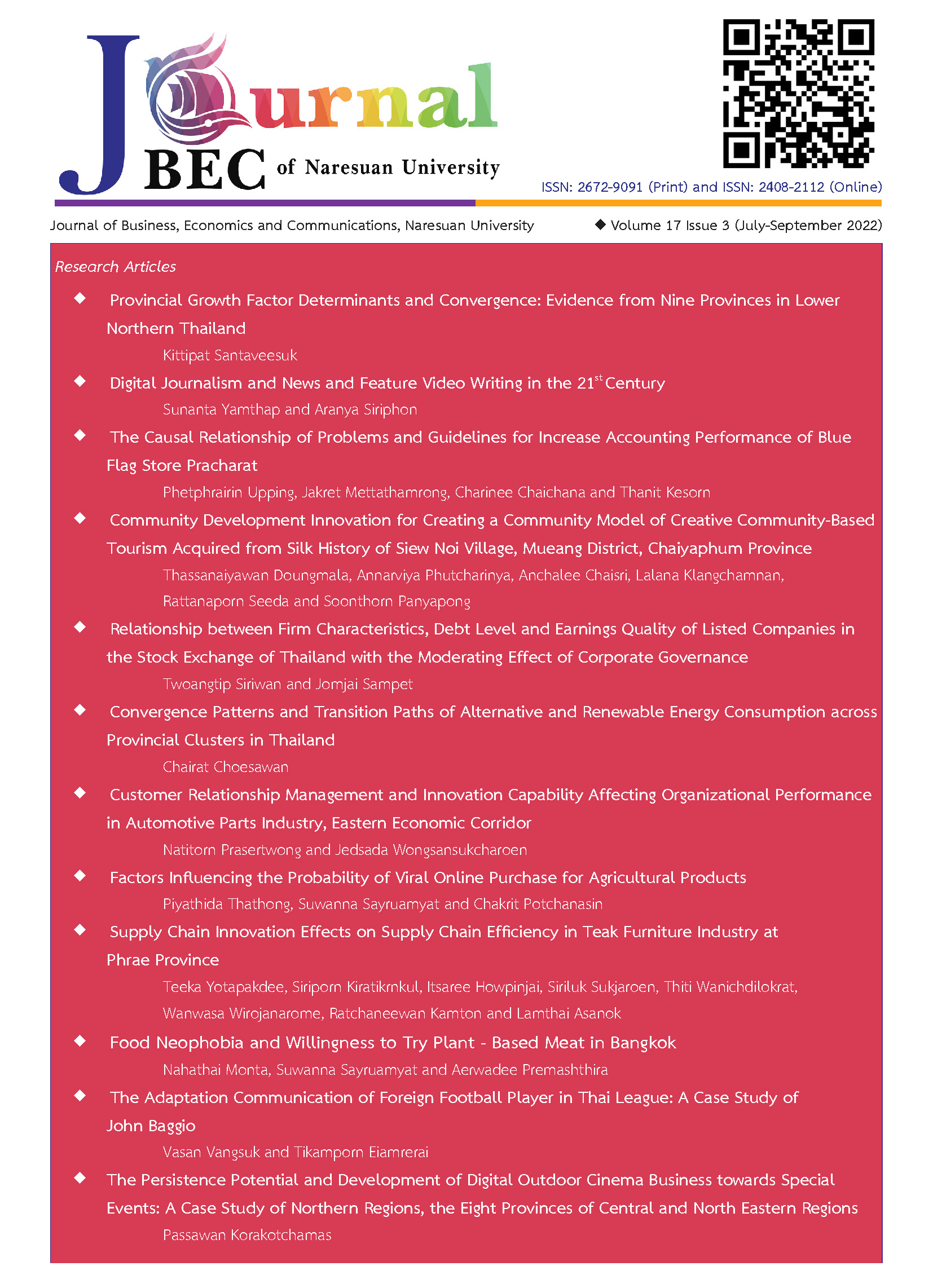Factors Influencing the Probability of Viral Online Purchase for Agricultural Products
Main Article Content
บทคัดย่อ
The aim of this paper is to critically investigate factors determine probability of viral online purchase for agricultural products. The study was conducted in the form of survey, with data being gathered via questionnaires from 271 respondents who aged between 22-60 years old and analyzed by ordered probit model. The results show that subjective norms, perceived behavioural control, satisfaction and trust in the system of buying agricultural products online significantly influences the probability of viral online purchase for agricultural products. These results suggest that farmers and agribusiness operators should pay close attention to after-sales services, such as checking the quality of products and solving customer issues immediately. It would increase the possibility of word-of-mouth.
Article Details

อนุญาตภายใต้เงื่อนไข Creative Commons Attribution-NonCommercial-NoDerivatives 4.0 International License.
เอกสารอ้างอิง
Ajzen, I. (1991). The theory of planned behaviour. Organizational behaviour and human decision process, 50(2), 179-211.
Alavion, S. J., Allahyari, M. S., Al-Rimawa, A. S. and Surujlal, A. S. (2016) Adoption of agricultural E-Marketing: Application of the theory of planned behaviour. Journal of International Food & Agribusiness Marketing, 29(1), 1-15.
Chai, L. and Pavlou, P. A. (2004). From “ancient” to “modern”: a cross-cultural investigation of electronic commerce adoption in Greece and the United States. Journal of Enterprise Information Management, 17(6), 416-423.
Conner, M. and Norman, P. (2015). Predicting and changing health behaviour (3rd ed.). Berkshire: McGraw-Hill Education.
Gu, S., and Wu, Y. (2019). Using the theory of planned behaviour to explain customers’ online purchase intention. World Scientific Research Journal, 5(9), 226-249.
Hair, J. F., Black, W. C., Babin, B. J., and Anderson, R. E. (2014). Multivariate data analysis. (7th ed.). Essex: Pearson Education.
Hofstede insights. (2001). Country comparison. Retrieved February 10, 2021, from https://www.hofstede-insights.com/country-comparison/thailand/
Jaisue, N. (2019). Technology acceptance and online consumer behaviour of Gen-X and Gen-Y influencing purchase intention for online agricultural product. Master thesis, M.B.A., Rajamangala University of Technology, Bangkok.
Ketabi, S. N., Ranjbarian, B. and Ansari, A. (2014). Analysis of the effective factors on online purchase intention through theory of planned behaviour. International Journal of Academic research in Business and Social Sciences, 4(4), 374-382.
Maichum, K., Parichanon, S. and Peng, K. (2016). Application of the extended theory of planned behaviour model to investigate purchase intention of green products among Thai consumers. Sustainability, 8(10), 1-20.
National Statistical Office Thailand. (2016). Sampling and estimation. Retrieved August 20, 2020, from http://service.nso.go.th/nso/nsopublish/Toneminute/files/55/A3-16.pdf
National Statistical Office Thailand. (2018). Number of internet users by internet activity in 2018. Retrieved August 9, 2020, from http://www.nso.go.th/sites/2014/Pages/Statistics%from%20major%20Survey.aspx
Noinart, W., Sriboonruang, P. and Rangsipaht, S. (2017). Factors related to purchasing decision towards pesticide free agricultural products of consumers, Golden Place shop, Kasetsart University Branch. King Mongkut's Agricultural Journal, 35(1), 136-145.
Office of Agricultural Economics. (2020). Covid has pushed consumers to pay more through the online marketplace. In March, agricultural sales rose by 45 million baht. Retrieved August 8, 2020, from https://bit.ly/3m5Yc7O
Omar, N. A., Nazri, M. A., Osman, L. H. and Ahmad M. S. (2016). The effect of demographic factors on consumer intention to purchase organic products in the Klang Valley: An empirical study. GEOGRAFIA Online Malaysian Journal of Society and Space, 12(2), 68-82.
Paul, J., Modi, A. and Patel, J. (2016). Predicting green product consumption using theory of planned behaviour and reasoned action. Journal of Retailing and Consumer Services, 29, 123-134.
Rameez, M. and Kulathunga, D. (2019). Customer’s online purchase intention: Applying extended theory of planned behaviour (TPB) model. Information and Knowledge Management, 9(10), 23-36.
Reichheld, F. F. (2006). The ultimate question: Driving good profits and true growth. Harvard: Business school press.
Rompho, N. (2012). Interesting customer performance indicators. Journal of Business Administration, 35(135), 4-7.
Schiffman, L. G. and Wisenblit, J. L. (2015). Consumer behaviour (11st ed.). Essex: Pearson Education.
Sriprianjun, S. and Chomvilailuk, R. (lecturer). (August 17, 2017). The effects of food online shoppingexperience and risk perceptions on food online purchase intention. In The twelfth RSU Graduate Research Conference 2017 (pp. 417-425). Bangkok: Rangsit University.
Wahyudi, A., Kuwornu, J. K. M., Gunawan, E., Datta, A. and Nguyen, L. T. (2019). Factors influencing the frequency of consumers’ purchases of locally-produced rice in Indonesia: A poisson regression analysis. Agriculture, 9(6), 2-17.
We are Social and Hootsuite. (2020). Digital 2020: Global digital overview. Retrieved February 5, 2021, from https://datareportal.com/reports/digital-2020-global-digital-overview
We are Social and Hootsuite. (2021). Digital 2021: Global digital overview. Retrieved February 5, 2021, from https://datareportal.com/reports/digital-2021-global-overview-report


